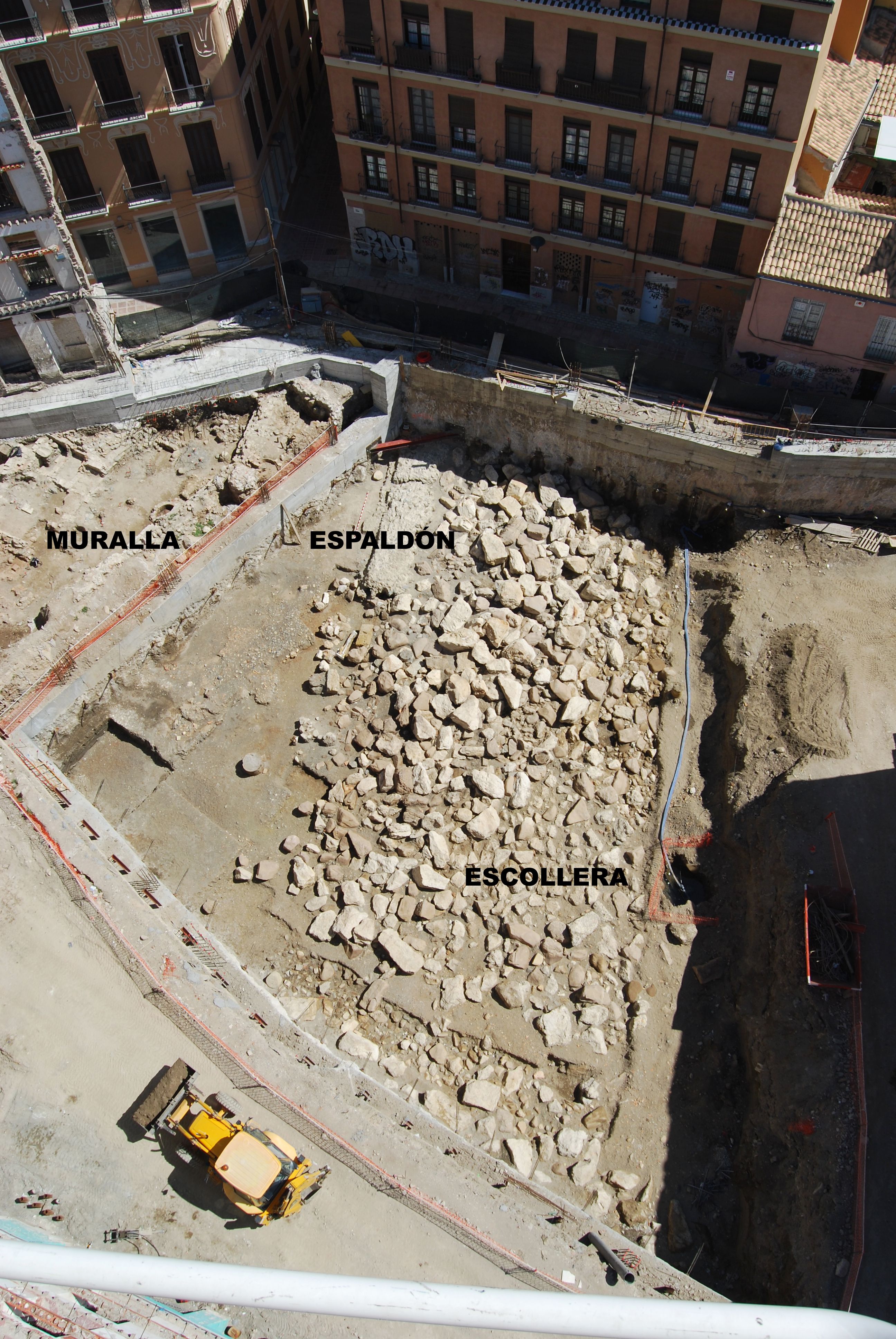HOTEL VINCCI CALLE PASILLO SANTA ISABEL 6-8
PUERTO ROMANO
Durante la intervención arqueológica llevada a cabo para la construcción del hotel Vincci Posada del Patio se produciría el descubrimiento de un espacio portuario de época tardorromana (finales del siglo III-IV d.C.). Se trataría de un fondeadero en el que las naves mayores recibían o descargaban las mercancías mediante transbordos a otras embarcaciones menores.
En la excavación arqueológica fueron identificados la escollera marítima, espaldón y muralla portuaria (integrada en los mismos sótanos del hotel), elementos estructurales que definen estos espacios portuarios. Así, la escollera estaba conformada por una extensa acumulación de bloques de piedra de gran tamaño, cuya finalidad sería reducir los efectos de los envites del mar. Situado tras la escollera, el espaldón se conforma como una construcción sometida a los fuertes envites del mar, lo que justifica que sólo se hayan identificado escasos restos de un sólido núcleo de calicanto, así como indicios que apuntan a la existencia de paramentos de mampostería bien careada y trabada con la masa del núcleo. Esta estructura se hallaba asegurada con hincas de madera, situadas a intervalos regulares, que la anclan al terreno, evitando desplazamientos laterales. También contaba con acanaladuras o aliviaderos que la atraviesan permitiendo la salida del aire producido por el retorno de las olas.
Por último, la muralla se conformaría como una estructura de gran porte, con hasta 2,50 metros de anchura y altura reducida, levantada sobre un sólido zócalo que penetraba profundamente en el subsuelo. Este elemento también disponía de sumideros por los que se evacuaban al exterior las aguas residuales del espacio intramuros.
Al interior de la muralla se abren varias estancias porticadas, almacenes de géneros para embarque o desembarco de mercancías para el mercado malagueño.
Este complejo portuario, situado entre la bahía malacitana y el delta del río Guadalmedina, cuyo uso se prolongó hasta el siglo V, pone de manifiesto la enorme capacidad comercial de la Malaca romana. Tras su abandono, este espacio sería destruido por una gran crecida del río.
Los restos del muro portuario identificado en el Pasillo Santa Isabel fueron integrados en el edificio del Hotel Vincci.
Director de la actividad: Alberto Cumpián Rodríguez
(Arqueosur, Estudio Arqueología, S.L.)
VINCCI HOTEL AT PASILLO SANTA ISABEL STREET 6-8
ROMAN PORT
During the archaeological work for the construction of the hotel Vincci Posada del Patio, a port area from the late Roman period (end of the 3rd-4th century AD) was discovered. This would have been an anchorage where the larger ships received or unloaded goods by means of transhipments to other smaller ships.
The archaeological excavation identified the maritime breakwater, shoulder and port wall (integrated into the hotel basements). These are structural elements that define these port spaces. The breakwater was made up of an extensive accumulation of large stone blocks, whose purpose was to reduce the effects of the sea. Situated behind the breakwater, the shoulder is shaped as a construction subjected to the strong impact of the waves. This justifies the fact that only a few remains of a solid core of masonry have been identified, as well as indications that point to the existence of well-faced masonry walls that were bonded to the mass of the core. This structure was secured with wooden piles, placed at regular intervals to anchor it to the ground and prevent lateral displacements. It also had grooves or spillways running through it to allow the waves to return.
Finally, the wall was a large structure, up to 2.50 metres wide and reduced in height, built on a solid plinth that penetrated deep into the subsoil. This element also had drains through which the waste water from inside the walls was evacuated to the outside.
Inside the wall there are several porticoed rooms, warehouses for the shipment or disembarkation of merchandise for the Málaga market.
This port complex was situated between the Bay of Malacca and the delta of the River Guadalmedina. The use of this port complex continued until the 5th century, demonstrating the enormous commercial capacity of Roman Malacca. After its abandonment, this area was destroyed by a great flood of the river.
The remains of the port wall identified in the Santa Isabel Hallway were integrated into the building of the Hotel Vincci.
Activity Director: Alberto Cumpián Rodríguez
(Arqueosur, Estudio Arqueología, S.L.)

